Effect of Maceration time on sensory characteristics of Cabernet Franc (2018)
Jordan Harris
Tarara Winery
Summary
Several factors contribute to the extraction of anthocyanins, tannins, aroma precursors and other components from grape skins and seeds during red wine fermentation. Cold soak is thought to increase color and aromatic complexity while extended maceration is thought to increase structure and body, though potentially at the cost of color and fruitiness. In this study, chemical and sensory effects of 5 days of cold soak and 8 days of extended maceration were measured for a Virginia Cabernet Franc. Cold soak led to wines with higher color intensity and lower hue while extended maceration wines had lower concentrations of anthocyanins. In sensory analysis, the cold soak wine was found to be different in a triangle test with astringency noted as a distinguishing characteristic. Extended maceration wine was not distinguished in a triangle test, however, in a separate ranking test, wine producers preferred the extended maceration wine to cold soak wines.
Introduction
All of the specific characteristics of sight, smell, and taste that differentiate red wines from white wines are due to the effects of extraction of compounds from skins and seeds during fermentation1. Usually skin and seed extraction is associated with color (anthocyanins) and astringency (tannin), however aroma precursors and polysaccharides2 are also present in skin cells. Compounds responsible for herbal, vegetal, bitter, leafy, grassy, phenolic, and aromatic compounds1 are all located in the same structures of skin cells, however, they are extracted at different rates with phenolic compounds usually extracted before herbal, vegetal and, bitter compounds1. For this reason, understanding of the compounds themselves and the winemaking techniques utilized to extract them can be crucial in producing high quality red wines.
Many factors contribute to the amount of extraction that occurs during a fermentation. Overall, riper grapes have less resistance to extraction due to the weakening of cell walls during ripening2. Enzymes, either produced by the grape itself or added during winemaking, increase extraction by weakening cell walls1,3. In addition to ripeness, time and temperature both increase extraction2. Also, cellar operations such as frequency and duration of cap management can affect extraction of compounds from skins and seedss3. There is also an interplay of components that affect the final result. For example, color is better in riper grapes probably due to better extraction of anthocyanins that lead to color but also of tannins that stabilize that color2. Also, care must be taken not to over-extract and cause harshness in the wine2.
One approach to increasing the extraction of color and flavor is cold soaking. Cold soak generally involves holding destemmed and crushed grapes at 15°C for 2-6 days to increase extraction of compounds into an aqueous medium (before ethanol is present)2. This approach is thought by some to produce fruitier wines with stronger color and smoother tannins2. Some also feel it enhances aromatic complexity1.
Chemically, a water based environment such as crushed grapes favors the extraction of anthocyanins along with sugar, acid, and potassium2. Crushing the grapes rather than leaving them whole releases water to contact the skins, leading to more extraction of skin compounds2. However, color is unstable until it is complexed with tannin molecules which have not been released yet (this requires time and alcohol), so some color is lost2. Formation of copigmentation complexes with other phenolics found in the pulp of grapes help stabilize color until polymeric pigments can be formed.
Zoecklein et al4 state that different bonds are formed in an aqueous vs. ethanol environment. Specifically, color and color stability may be increased because bonds can be formed in an oxidative environment which enhances phenol polymerization. So, though less tannin is available, that which is available is more likely to complex with anthocyanins to form stable complexes.
Another potential effect of cold soak is the activity of non-Saccharomyces yeast. These yeast have been shown to release flavor precursors that Saccharomyces later transform. They can also increase fruity aromas through the production of significant amounts of esters.2 Yet, cold soak is also a time for un-favorable effects of non-Saccharomyces yeast. Hanseniaspora (AKA Klockera) is the main species found on mature grapes, which can produce positive compounds as described above, however this cryotolerant yeast can also produce large amounts of ethyl acetate and acetic acid.
The literature is very mixed as to the effects of cold soak. Several studies have failed to find differences in anthocyanins and tannins with cold soak while others have reported benefits1,2. Zoecklein et al (1994) found cold soaking Cabernet Sauvignon lowers hue and increases color intensity5. Inconsistency in the literature on the effects of cold soak are likely due to several other confounding factors such as variety, ripeness, other cellar operations such as cap management, temperature, etc… It is therefore useful to explore these effects on local grapes in your own cellar conditions.
Another approach to increasing extraction for red wine quality includes extended maceration. During extended maceration, finished wine is left in contact with skins and seeds after completion of primary fermentation, often with gassing to prevent oxidation and accumulation of volatile acidity. Extended maceration commonly lasts 2-4 weeks. Extended maceration is expected to produce different effects than cold soak due to the ethanol rich environment of finished wine.
Phenolics are polar compounds and are thus better extracted in ethanol than water2. Extended maceration in an alcohol rich environment favors the extraction of tannin from skins and seeds2. Some aroma precursors are also non-polar2 so extended maceration also includes the solublization of polysaccharides, proteins and peptides in grape and yeast cell walls4. Zoecklein et al (1995) state that, for the above reasons, extended maceration produces wines with greater body, depth, complexity, color stability4.
Figure 12.9 from The Handbook of Enology1 illustrates the progression of phenolic extraction well. 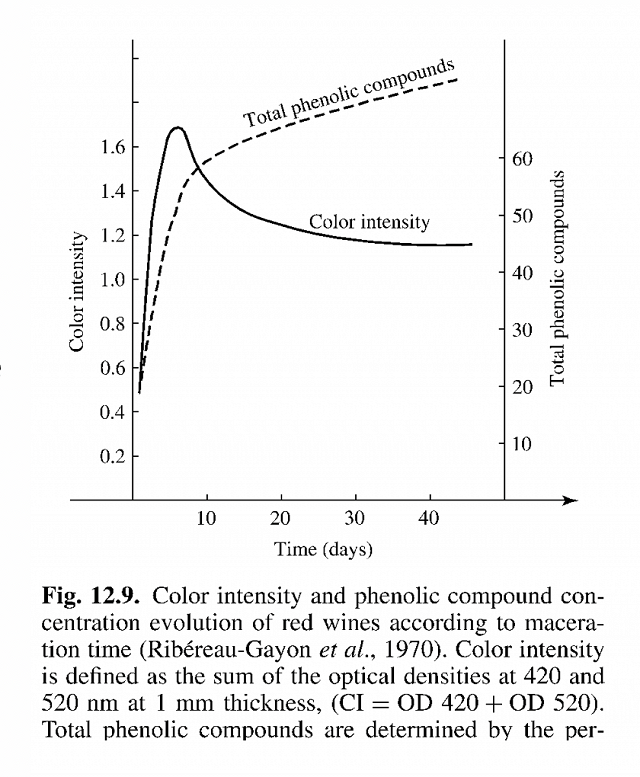 Color increases quickly as cells burst and anthocyanins are extracted into the water-based environment of the juice, however, little tannin is available to stabilize these anthocyanins, so the concentration falls off.
Color increases quickly as cells burst and anthocyanins are extracted into the water-based environment of the juice, however, little tannin is available to stabilize these anthocyanins, so the concentration falls off.
Anthocyanin concentration reaches a peak 6 days after the beginning of fermentation and declines after that. Extended maceration leads to continued decline in color. Skin tannins start to be extracted soon after anthocyanins as skin cells break down due to grape enzymes. Ethanol begins to build up which increases this extraction. Over time, ethanol works to weaken the waxy cuticle around seeds, leading to increased extraction of seed tannins2that are unavailable in an aqueous (juice) environment. So, as extended maceration continues, tannin levels continue to climb but the balance shifts to seed tannin over skin tannin. Tannins continue to evolve during this time. Higher molecular weight tannins form due to polymerization of smaller subunits, leading to softening of astringency4. Though not shown in the graph, fruitiness is inversely correlated with phenol level4.
Pressing early, immediately after the completion of alcoholic fermentation, produces a wine with more color and less tannin; a fruit driven early release wine. Extended maceration for 30 days produces a more structured wine with less color and potentially more evolved tannins. However, fruitiness may be lost, volatile acidity may climb and tannins may become over extracted. For these reasons it is crucial to taste the wines regularly during extended maceration to determine the extent of tannin extraction and evolution (with air and time) as well as limit extraction of harsh seed tannins.
The aim of this study is to test the effect of cold soak and extended maceration on color, flavor and structure, and in Virginia Cabernet Franc.
Methods
At the time of harvest, grapes were divided equally and randomly by alternating rows of the vineyard pick between four identical TBins, each of which was subjected to a different extraction protocol (Figure 1):
- No cold soak, pressing after completion of alcoholic fermentation (no extended maceration). This treatment is referred to as “control”.
- No cold soak, extended maceration for 8 days post alcoholic fermentation
- Cold soak for 5 days, pressing after completion of alcoholic fermentation (no extended maceration)
- Cold soak 5 days, extended maceration for 8 days post alcoholic fermentation
NOTE: The typical Cabernet Franc fermentation at Tarara Winery includes 7-10 days of cold soak, and a full 30 days of extended maceration after the completion of fermentation. However, due to the conditions of the 2018 growing season, cold soak was shortened to 5 days while extended maceration was shortened to 8 days.
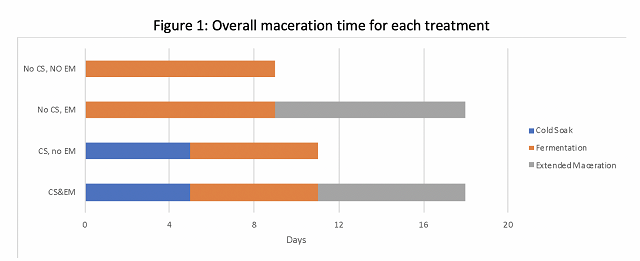
Grapes were harvested on September 21. All grapes were refrigerated overnight prior to processing on September 22. Each TBin received the same additions, winemaking treatments and cap management regime until the time of pressing. Briefly, fruit was destemmed and pumped to tank with no additional additives. Saignée was performed with care taken to maintain the same proportion of skins to juice. Roughly 20% (32 gallons per ton) of the liquid volume was removed from each bin, with measurement of volume of the bleed and the weight of fruit in the TBin used as a guide.
Tbins receiving cold soak were treated with dry ice, covered in plastic sheeting and lidded, then put in a refrigerated environment for 5 days with one daily punchdown. All bins received 33 g/L sugar and 2 g/L tartaric acid 2 days after the fruit was harvested, 24 hours after destemming.
To initiate fermentation (immediately for treatments 1 and 2 after 5 days for treatments 3 and 4), D254 yeast was rehydrated in 20 g/hL Go Ferm. Fermentations were warmed to a target of 59°F prior to inoculation. Fermentations were monitored daily for Brix and temperature with target temperature for peak fermentation between 75-88 °F. If temperatures rose above 88°F, bins were placed in a refrigerated environment.
TBins were punched down three times per day during active fermentation (7 am, 12pm, 7 pm). Bins were pressed when fermentation monitoring indicated sugar had been depleted unless they were designated for extended maceration. Wine was inoculated with 1 g/hL O-Mega (Scottlabs) 24 hours after pressing to start malolactic fermentation, then transferred to third use 2014 Magrenan Jupilles barrels. Malic acid depletion was monitored using enzymatic methods. SO2 (50 ppm ) was added at completion of malolactic fermentation without racking, checked monthly, and maintained at a target of 30ppm.
Sensory analysis was conducted in two different sensory sessions. The first included a panel of 28 wine producers. Three flights were evaluated. First, control and cold soak only wines were presented blind in randomly numbered glasses. Tasters were presented with three wines, two of one type and one of another, and asked to identify which wine was different (a triangle test). There were three tasting groups with the unique wine in the triangle test balanced between groups. Tasters were then asked to score each wine on a scale of 0 to 10 for fruit intensity, color and astringency. They were also given open ended questions to describe the wines. A second flight included the same methodology comparing control and extended maceration wines, using descriptors for fruit intensity, body and astringency. A third flight included presentation of all four wines. Tasters were asked to rank the wines with 1=most preferred and 4=least preferred. They were also asked to score the wines for fruit intensity and astringency, once again with space given for open ended descriptors. In the second sensory session, only the comparison of cold soak and control wines was evaluated by 21 wine producers Results for the triangle test were analyzed using a one-tailed Z test while ranking was evaluated using Friedman’s test. Descriptive scores were analyzed using repeated measures ANOVA. Scores from separate sensory sessions were kept separate for statistical analysis.
Results
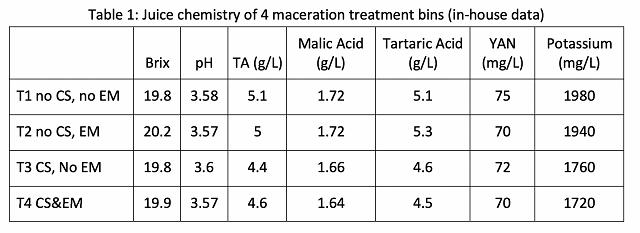
Each bin received fruit with roughly equivalent starting chemistry (Table 1). Brix values ranged from 19.8 to 20.2 while pH ranged from 3.57 to 3.6. Potassium in T1 and T2 appeared to be higher than potassium in T3 and T4. Fermentation kinetics for the 4 maceration treatments can be found in Figure 2. Treatments 1 and 2 fermented faster, completing fermentation (as measured by negative Brix readings) on day 8. Treatment 3 completed fermentation on day 9 and treatment 4 completed fermentation on day 11. Treatments 1-3 all had a maximum temperature of 84°F (on Day 7 for treatments 1 and 2 and day 9 for treatment 3) while treatment 4 reached a maximum temperature of 91°F on day 9. It is not clear why treatment 3 completed fermentation two days before treatment 4 unless stress to the yeast due to high temperatures on day 8 slowed the fermentation in treatment 4.
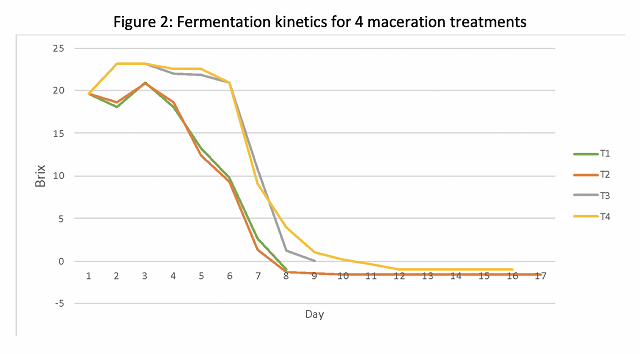
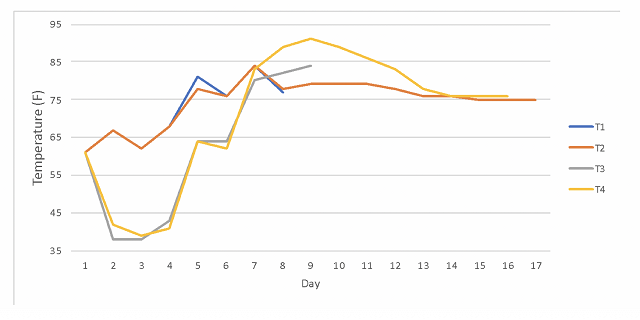
Finished wine chemistry was very similar in all treatments (Table 2), however there were differences in color and concentration of pigments between treatments (Table 3, 4). Wines without cold soak (T1 and T2) had lower color intensity than those with cold soak, with T3 (cold soak only) wine having the highest color intensity and lowest hue (the most red). The concentration of anthocyanins seemed to depend on the duration of maceration, with the shortest maceration wines (T1 and T3) having the highest concentrations of anthocyanins. Extended maceration wines (T2 and T4) had lower concentration of anthocyanins.
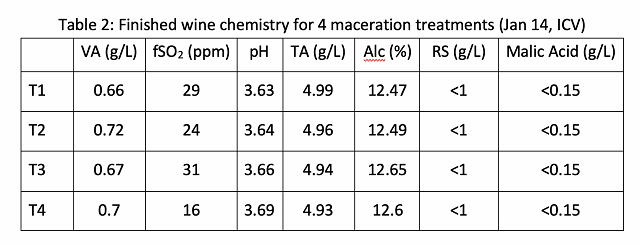
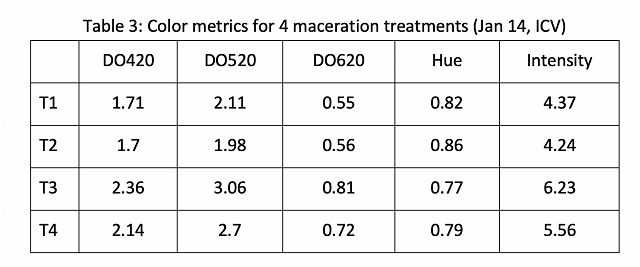
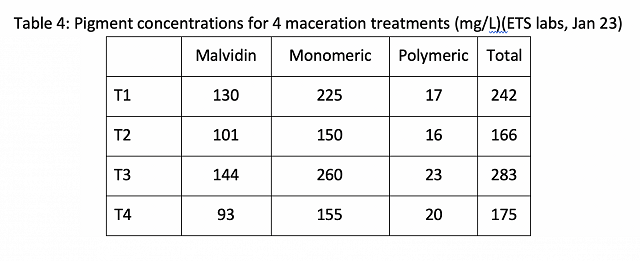
As expected, seed phenolics (gallic acid, catechin, epicatechin) were elevated in wines with extended maceration (T2 and T4). Tannin and skin phenolic levels increased with cold soak (T3 and T4).
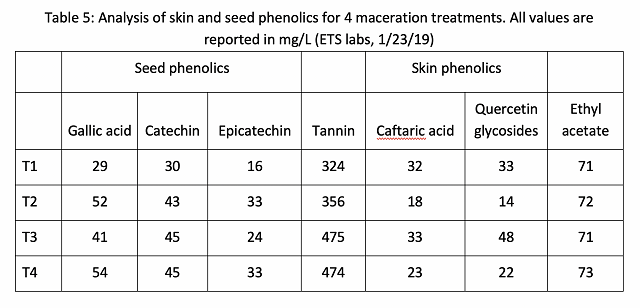
In a triangle test of control and cold soak only wines, 15 out of 28 respondents were able to distinguish which wine was different in the first sensory session, indicating the wines were significantly different (Z=2.07, p= 0.0192). These results were confirmed in the second sensory session where 12 of 21 respondents were able to distinguish the wines (Z=2.08, p=0.0188). When asked in open ended questions what distinguished the wines, respondents cited astringency in the cold soak wine, which is consistent with the higher levels of tannin in this wine. There were no significant differences in scores for fruit intensity (F=0.39, p= 0.54; F=0.11p=0.75) nor color (F=2.66, p= 0.11; F=0.65, p=0.43) in either tasting. In the first tasting, the cold soak wine had higher scores for astringency than the control wine in the first tasting that was nearly significant (F=3.7 p= 0.065), however, this difference was not seen in the second tasting, with identical means for both treatments.
Respondents were not able to distinguish the difference between control and wine that had undergone extended maceration (Z=0.204, p=0.42), indicating these wines were not significantly different. There were also no differences in scores for fruit intensity (F=1.5, p=0.2), body (F=0.358, p=0.56), or astringency (F=-.191, p=0.67).
When presented with all four wines and asked to rank them, respondents significantly preferred treatment 2, extended maceration only to either of the wines that had received cold soak. There were no differences in fruit intensity (F=1.18, p=0.32) or astringency (F=2.12, p=0.1027) scores among these wines. Astringency was nearly significantly different, as T3 (cold soak only) had higher mean score for astringency than the other three treatments, despite having lower seed tannins. It is possible that the duration of extended maceration allowed polymerization of tannin that reduced the perception of astringency in these wines.
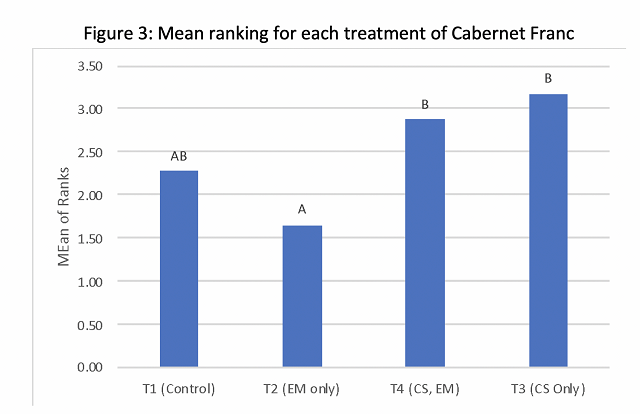
Preliminary Conclusions
Cold soak led to increase in the color intensity of the wine, but this increase was not perceptibly different in sensory analysis. This treatment also led to higher tannin and skin phenolics, leading to descriptors of higher astringency and nearly significantly different scores for astringency. This increase was not preferred, however, as cold soak wine was the least preferred of the four wines. Extended maceration led to an increase in seed phenolics and was the most preferred wine. It is possible extended maceration allowed for polymerization of tannins that led to more pleasant astringency than found in the cold soak wines.
References
(1) Ribereau-Gayon, P.; Dubourdieu, D.; Doneche, B.; Lonvaud, A. Handbook of Enology Volume 1: The Microbiology of Wine and Vinifications, 2nd ed.; John Wiley & Sons: West Sussex, England, 2006.
(2) Razungles, A. Extraction Technologies and Wine Quality. In Managing Wine Quality: Volume 2 – oenology and wine quality; Woodhead Publishing: Cambridge, 2010; Vol. 2.
(3) Sacchi, K. L.; Bisson, L. F.; Adams, D. O. A Review of the Effect of Winemaking Techniques on Phenolic Extraction in Red Wines. 2005, 10.
(4) Zoecklein, B.; Fugelsang, K. C.; Gump, B. H.; Nury, F. S. Wine Analysis and Production; Springer: New York, 1995.
(5) Zoecklein, B. Effect of Cold Soak and Alcohol Concentration at Dejuicing on Cabernet Sauvignon Glycosides. Vintner’s Corner 1998, 12 (2).
